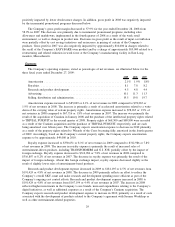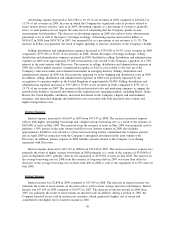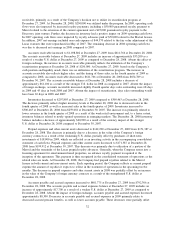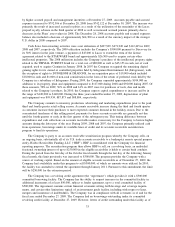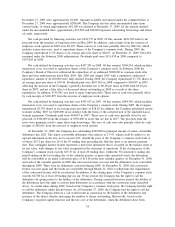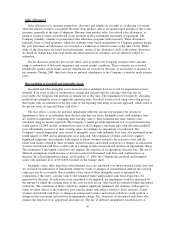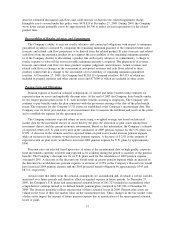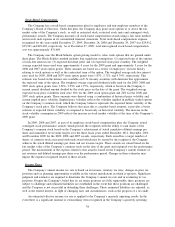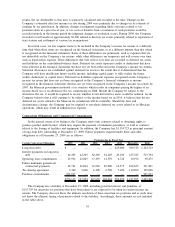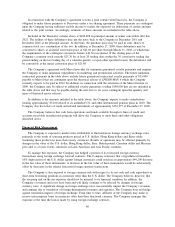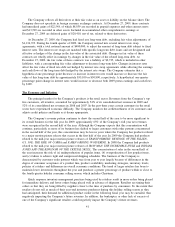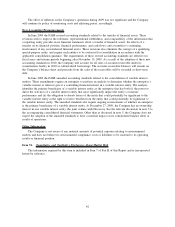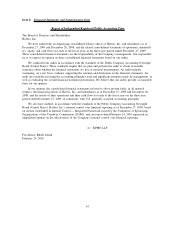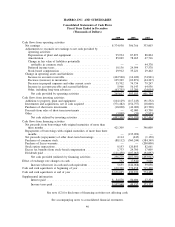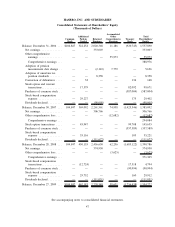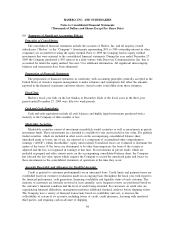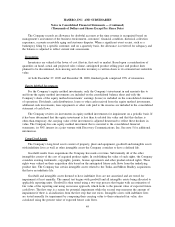Hasbro 2009 Annual Report Download - page 49
Download and view the complete annual report
Please find page 49 of the 2009 Hasbro annual report below. You can navigate through the pages in the report by either clicking on the pages listed below, or by using the keyword search tool below to find specific information within the annual report.
results, the tax attributable to that item is separately calculated and recorded at the time. Changes in the
Company’s estimated effective income tax rate during 2009 were primarily due to changes in its estimate of
earnings by tax jurisdiction. In addition, changes in judgment regarding likely outcomes related to tax
positions taken in a prior fiscal year, or tax costs or benefits from a resolution of such positions would be
recorded entirely in the interim period the judgment changes or resolution occurs. During 2009, the Company
recorded a total benefit of approximately $2,300 related to discrete tax events primarily related to expiration of
state statutes and settlement of various tax examinations.
In certain cases, tax law requires items to be included in the Company’s income tax returns at a different
time than when these items are recognized on the financial statements or at a different amount than that which
is recognized on the financial statements. Some of these differences are permanent, such as expenses that are
not deductible on the Company’s tax returns, while other differences are temporary and will reverse over time,
such as depreciation expense. These differences that will reverse over time are recorded as deferred tax assets
and liabilities on the consolidated balance sheet. Deferred tax assets represent credits or deductions that have
been reflected in the financial statements but have not yet been reflected in the Company’s income tax returns.
Valuation allowances are established against deferred tax assets to the extent that it is determined that the
Company will have insufficient future taxable income, including capital gains, to fully realize the future
credits, deductions or capital losses. Deferred tax liabilities represent expenses recognized on the Company’s
income tax return that have not yet been recognized in the Company’s financial statements or income
recognized in the financial statements that has not yet been recognized in the Company’s income tax return. In
2007, the Mexican government instituted a tax structure which results in companies paying the higher of an
income-based tax or an alternative flat tax commencing in 2008. Should the Company be subject to the
alternative flat tax, it would be required to review whether its net deferred tax assets would be realized. As the
Company believes that it will continue to be subject to the income-based tax in 2010, it believes that the net
deferred tax assets related to the Mexican tax jurisdiction will be realizable. Should the facts and
circumstances change, the Company may be required to reevaluate deferred tax assets related to its Mexican
operations, which may result in additional tax expense.
Contractual Obligations and Commercial Commitments
In the normal course of its business, the Company enters into contracts related to obtaining rights to
produce product under license, which may require the payment of minimum guarantees, as well as contracts
related to the leasing of facilities and equipment. In addition, the Company has $1,134,723 in principal amount
of long-term debt outstanding at December 27, 2009. Future payments required under these and other
obligations as of December 27, 2009 are as follows:
Certain Contractual Obligations 2010 2011 2012 2013 2014 Thereafter Total
Payments due by Fiscal Year
Long-term debt.............. $ — — — — 425,000 709,723 1,134,723
Interest payments on long-term
debt .................... 62,205 62,205 62,205 62,205 49,189 215,785 513,794
Operating lease commitments . . . 25,932 22,845 17,439 14,559 6,728 10,972 98,475
Future minimum guaranteed
contractual payments . . ...... 32,761 36,804 61,926 85,000 14,375 100,625 331,491
Tax sharing agreement . . ...... 3,300 5,600 6,100 6,700 7,100 110,200 139,000
Purchase commitments . . ...... 251,917 — — — — — 251,917
$376,115 127,454 147,670 168,464 502,392 1,147,305 2,469,400
The Company has a liability at December 27, 2009, including potential interest and penalties, of
$115,795 for uncertain tax positions that have been taken or are expected to be taken in various income tax
returns. The Company does not know the ultimate resolution of these uncertain tax positions and as such, does
not know the ultimate timing of payments related to this liability. Accordingly, these amounts are not included
in the table above.
39


